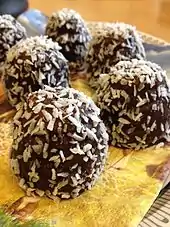Oatmeal ball
The oatmeal ball (Danish: havregrynskugle) or the chocolate ball (Swedish: chokladboll) is a type of unbaked pastry that is a popular Danish and Swedish confectionery.
 Oatmeal balls rolled in shredded coconut | |
| Place of origin | Sweden |
|---|---|
| Main ingredients | Oatmeal, sugar, coffee, cocoa, butter |
Oatmeal balls consist of oatmeal, sugar, cocoa,[1] vanilla sugar, butter, and sometimes a small amount of coffee mixed until they become a compact mass. To make them creamier and softer, some people also like to mix in a splash of cream. From the dough, balls are hand-formed to a size usually slightly smaller than golf balls, then rolled in shredded coconut[1] or sprinkles. The balls can be eaten immediately, but usually they are first chilled in a refrigerator.
Because of the simple, non-bake recipe, oatmeal balls can be quickly made by anyone, which makes them one of the most popular homemade sweets and a common sight at children's parties.
Variations on the oatmeal ball are popular in other countries too. In Israel, Petit Beurre crumbs take the place of the oatmeal, and the candy is called in Hebrew: כדור שוקולד, romanized: Kadur Shokolad, lit. 'chocolate ball'. Popular in Austria, especially around Christmastime, is the Rumkugel (plural Rumkugeln), which contains the same ingredients as oatmeal balls but adds a small amount of rum to the mix.
History
The oatmeal ball was most likely invented during World War II, when, because of rationing, there was a limited supply of wheat flour, which caused a search for substitutes. In 1943, the Danish Nationaltidende published a small booklet for housewives called Ingenuity in a time of crisis (Danish: Opfindsomhed i en krisetid) containing the recipe for havregrynskugle.[2] There is also a classified ad for a konditorei product with the name negerbollar from 1918 in the Swedish newspaper Svenska Dagbladet. Although the content is unknown, they are described as "chocolate-coco" and are sold in boxes of 300 at 1.5 kilograms (3.3 lb).[3]
Names in Swedish

One traditional name for the pastry in Swedish is negerboll ("negro ball").[4] Due to possible racist connotations, this name has fallen out of favor in recent decades, with chokladboll (chocolate ball) now being the most commonly used name. When made with shredded coconut, it is also known as kokosboll (coconut ball).
The appropriateness of negerboll as the name of the pastry has been the subject of media debate, intensified by neger now generally being considered an ethnic slur, having undergone a similar change in tone to English Negro.[5] Chokladboll was first added to the Swedish Academy's spelling dictionary Svenska Akademiens ordlista in 2006, with only negerboll being listed prior. In the 13th (2006) edition, the pastry can be found under both names, with a comment that chokladboll is the recommended term.[6] In the 14th edition (2015) negerboll was removed.[7][8]
In mid-2003, a bakery owner from Sjöbo was reported to the Swedish Ombudsman against Ethnic Discrimination for using the word negerboll on a sign in her bakery shop.[9] However, the case was dismissed since the person reporting it did not consider herself personally insulted.
Note that the Danish word negerbolle is a similarly dated term for a similar but different confection, namely the flødebolle.
See also
References
- Swedish Phrasebook. Eton Institute – Language Phrasebook. Eton Institute. 2013. p. pt20. Retrieved 29 January 2017.
- Palsbo, Susanne (1943). Opfindsomhed i en Krisetid : en Haandfuld Rationeringsopskrifter og aktuelle Husholdningsraad (in Danish). Copenhagen: Nationaltidende. p. 62.
- "Negerbollar". Svenska Dagbladet. 8 July 1918. p. 14. Retrieved 20 August 2020.

- "Vi jular gott". Svenska Dagbladet. 14 December 1943. Retrieved 15 November 2018.
- "'Negro ball' scrapped from Swedish dictionary". The Local. 23 March 2015. Retrieved 29 January 2017.
- Page 611 in Svenska Akademiens ordlista över svenska språket, 2006
- "Nu tas "negerboll" och andra kränkande ord bort ur ordlistan" (in Swedish). Aftonbladet. 23 March 2015. Retrieved 7 May 2018.
- Page 869 in Svenska Akademiens ordlista över svenska språket 2015.
- "Negerboll kan kränka enskild" (in Swedish). Svenska dagbladet. 24 January 2004. Retrieved 14 March 2017.